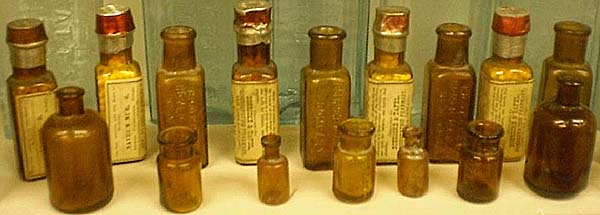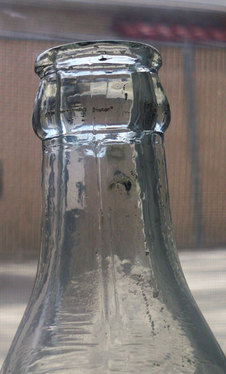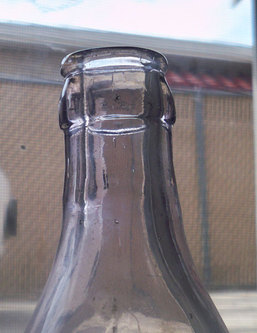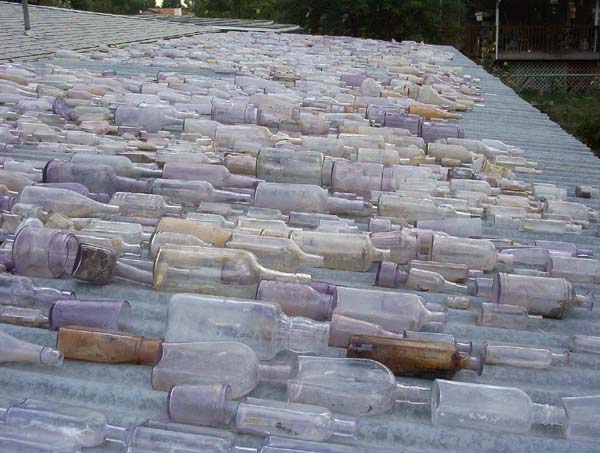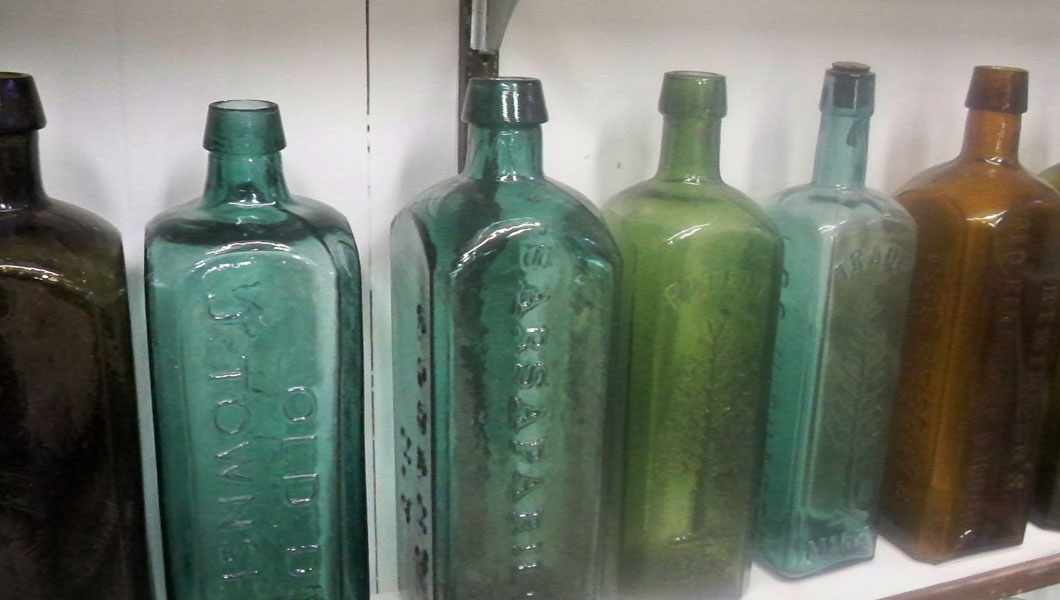|
Is it Old?
Almost everyone has an "old bottle" somewhere. The term antique is somewhat subjective and a bottle doesn't even have to be antique to be collectible. What collectors look for is bottles that were hand-made. The date that I use is pre-1915. Around that time, the anufacturers began making bottles by machine. The more sophisticated the industry became, the less interesting the bottles became.
They lost a lot of the unique characteristics that make them collectible. Plus, now they could be pumped out in mass quantities.
To determine if a bottle is hand-made, you have to check the seam of the bottle. Generally the bottle was molded in halves. You
will find a line of glass seam running up the side of the bottle and, if it was hand-made, the seam will stop about an inch from the top and it looks like the lip was spun or tooled by hand. On a machine made bottle the seam is much finer and will go clear over the top lip.
No -touching was required. Hand-made bottles are usually all unique. They have lots of flaws, bubbles, color variations and are generally crude. That's what makes them so special. The older bottles would Emboss the name and content in the glass. It makes them identifiable and provides a way to give them a pretty exact date in time.
Almost everyone has an "old bottle" somewhere. The term antique is somewhat subjective and a bottle doesn't even have to be antique to be collectible. What collectors look for is bottles that were hand-made. The date that I use is pre-1915. Around that time, the anufacturers began making bottles by machine. The more sophisticated the industry became, the less interesting the bottles became.
They lost a lot of the unique characteristics that make them collectible. Plus, now they could be pumped out in mass quantities.
To determine if a bottle is hand-made, you have to check the seam of the bottle. Generally the bottle was molded in halves. You
will find a line of glass seam running up the side of the bottle and, if it was hand-made, the seam will stop about an inch from the top and it looks like the lip was spun or tooled by hand. On a machine made bottle the seam is much finer and will go clear over the top lip.
No -touching was required. Hand-made bottles are usually all unique. They have lots of flaws, bubbles, color variations and are generally crude. That's what makes them so special. The older bottles would Emboss the name and content in the glass. It makes them identifiable and provides a way to give them a pretty exact date in time.
|
This seam goes over the top. See it coming up the middle, continuing up over the lip. Machine made.
|
This seam comes up the middle and then stops about an inch to two inches from the top. You see a slight bulge in the neck where the hand tooling began. Hand-made.
|
Clearly shaped by hand. See you are already getting it!
|
One of the fun aspects of old glass is that clear bottles that are pre-1915 turn amethyst when exposed to the sun's rays. The chemical in the
glass that was used to make them clear, reacts to ultra-violet rays. Some turn quickly in a year and some take years. They all turn differently.
None of the other colored bottles turn, only the clear. (ok, some milk glass will go pink.)
glass that was used to make them clear, reacts to ultra-violet rays. Some turn quickly in a year and some take years. They all turn differently.
None of the other colored bottles turn, only the clear. (ok, some milk glass will go pink.)
|
This is not easy to explain to your neighbors and Spouse. You will see the varying degrees of color. Some have been up a few years, some for more than a few years. Purples are clearly old. You know they
are pre 1920. No question. Bottle collectors believe that all roofs wer made to help turn their clear bottles purple. |
The machine-made bottles generally went to an applied label. Far fewer were embossed.The pure food and drug act eliminated the outrageous
cure-all entrepreneurs and paved the way for mostly clear glass so you could see what you were getting. Of course there are still many collectible newer bottles. The factors of shape, color and embossing still apply to machine-made bottles.
Is it Valuable?
There are many antique bottles out there. Even though they are 100 years old, they are not all valuable. For each good bottle you will find a
hundred that aren't. So let's start with the least valuable and work up.
Blanks- These are old bottles that were labeled. The label is worn off and you can't identify what was in the bottle. It is old and interesting but will only be valuable for it's age and at best will bring a few dollars.
Color - The most common colors were aqua and amber. The clear ones go purple in the rays of the sun and seem to be more interesting to potential collectors. The other colors; olive, honey amber, greens and every other shade possible. Milk Glass and Cobalt Blue bottles are
more desirable. The color can easily make a bottle more collectible than another. Many collectors look for their favorite bottle in a variety of
shades.
cure-all entrepreneurs and paved the way for mostly clear glass so you could see what you were getting. Of course there are still many collectible newer bottles. The factors of shape, color and embossing still apply to machine-made bottles.
Is it Valuable?
There are many antique bottles out there. Even though they are 100 years old, they are not all valuable. For each good bottle you will find a
hundred that aren't. So let's start with the least valuable and work up.
Blanks- These are old bottles that were labeled. The label is worn off and you can't identify what was in the bottle. It is old and interesting but will only be valuable for it's age and at best will bring a few dollars.
Color - The most common colors were aqua and amber. The clear ones go purple in the rays of the sun and seem to be more interesting to potential collectors. The other colors; olive, honey amber, greens and every other shade possible. Milk Glass and Cobalt Blue bottles are
more desirable. The color can easily make a bottle more collectible than another. Many collectors look for their favorite bottle in a variety of
shades.
Shape - Unique shapes and styles will add value. A figural bottle is more desirable than a plain shaped bottle.
Embossing - The embossing provides the final touch of collectability. You can identify the bottle uniquely and determine its rarity. It's
what separates the good from the mediocre and gives the bottle its special place in history.
Rarity- When you get all of the above factors together you can determine the rarity.
Embossing - The embossing provides the final touch of collectability. You can identify the bottle uniquely and determine its rarity. It's
what separates the good from the mediocre and gives the bottle its special place in history.
Rarity- When you get all of the above factors together you can determine the rarity.
There are many bottle pricing guides in bookstores and in libraries. There are many sites that will tell you the value of your bottle. Do
some research, have a good time and see if you have found a treasure!
How do I clean it?
Most of the bottles you find will be dirty from being in the ground or being in a trash heap for 100 years. Scrubbing the outside is easy using a brush or tooth brush and a soft scrubbing cleanser. Steel wool could scratch the glass. The inside requires a bit more artistry.
Use a small brush like a percolator brush to get what you can. Use a larger brush for those with larger openings.
Sometimes a product like Lime-away will loosen some of the deposits inside. For tougher dirt, you need to use sand or fine gravel, or some tumbling type agent, inside the bottle and shake it around to get the dirt out. In many cases, the soil that captured the bottle when it was thrown away will etch and cloud the glass with a haze or opalescence. It won't come out. It is now part of the glass.
In that case, your primary alternative is to tumble the bottle. This is usually reserved for more valuable bottles.
Final Note
Even though the opportunities for easy digging are limited, there are still many antique bottles in the ground. Be aware and get involved.
If you know any diggers, have them tell you the stories. You can still make some wonderful finds. Plus, I have always been active in
collecting even though, I haven't been digging for many years.
Glass breaks. Old bottles will always be more scarce.
Buy, sell, trade. The investments I have made over the last 10 years have more than doubled in value.
But beware. Once you are bitten, there is no cure.
Happy collecting!
some research, have a good time and see if you have found a treasure!
How do I clean it?
Most of the bottles you find will be dirty from being in the ground or being in a trash heap for 100 years. Scrubbing the outside is easy using a brush or tooth brush and a soft scrubbing cleanser. Steel wool could scratch the glass. The inside requires a bit more artistry.
Use a small brush like a percolator brush to get what you can. Use a larger brush for those with larger openings.
Sometimes a product like Lime-away will loosen some of the deposits inside. For tougher dirt, you need to use sand or fine gravel, or some tumbling type agent, inside the bottle and shake it around to get the dirt out. In many cases, the soil that captured the bottle when it was thrown away will etch and cloud the glass with a haze or opalescence. It won't come out. It is now part of the glass.
In that case, your primary alternative is to tumble the bottle. This is usually reserved for more valuable bottles.
Final Note
Even though the opportunities for easy digging are limited, there are still many antique bottles in the ground. Be aware and get involved.
If you know any diggers, have them tell you the stories. You can still make some wonderful finds. Plus, I have always been active in
collecting even though, I haven't been digging for many years.
Glass breaks. Old bottles will always be more scarce.
Buy, sell, trade. The investments I have made over the last 10 years have more than doubled in value.
But beware. Once you are bitten, there is no cure.
Happy collecting!

